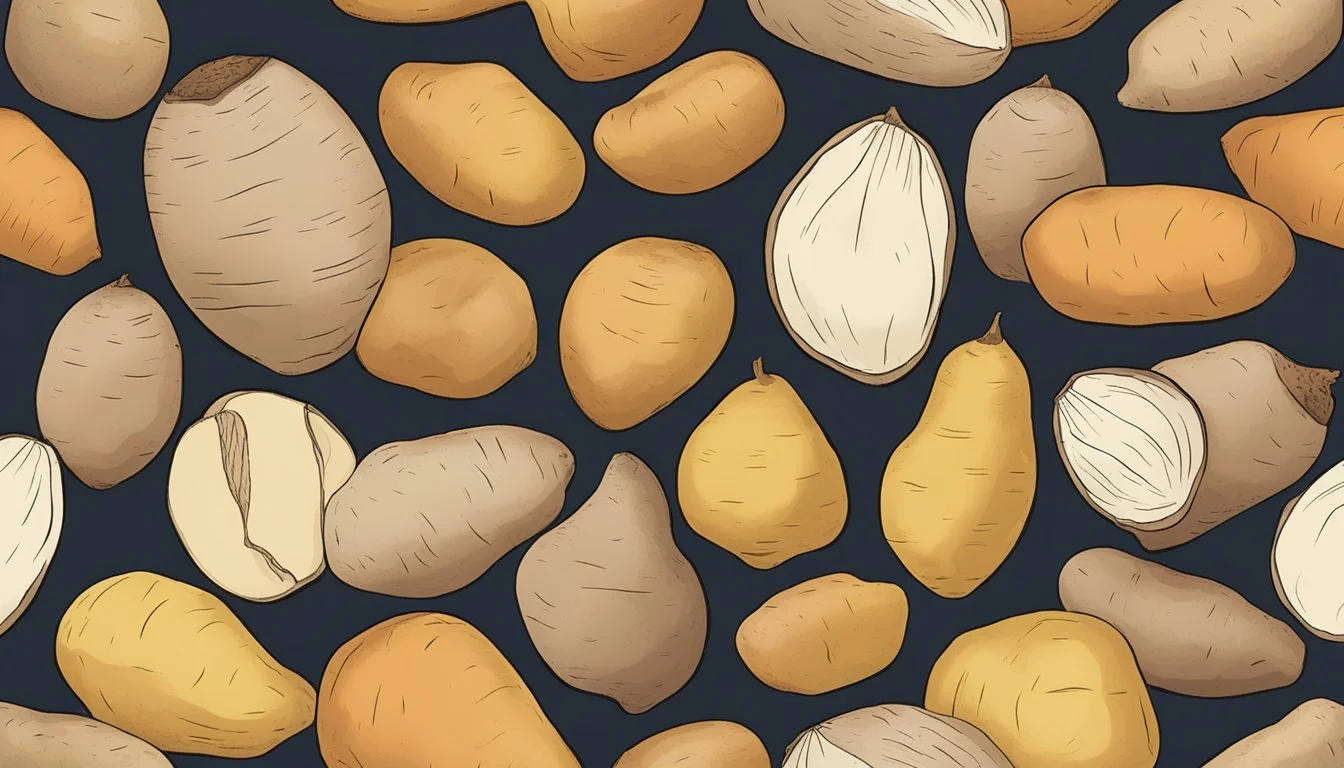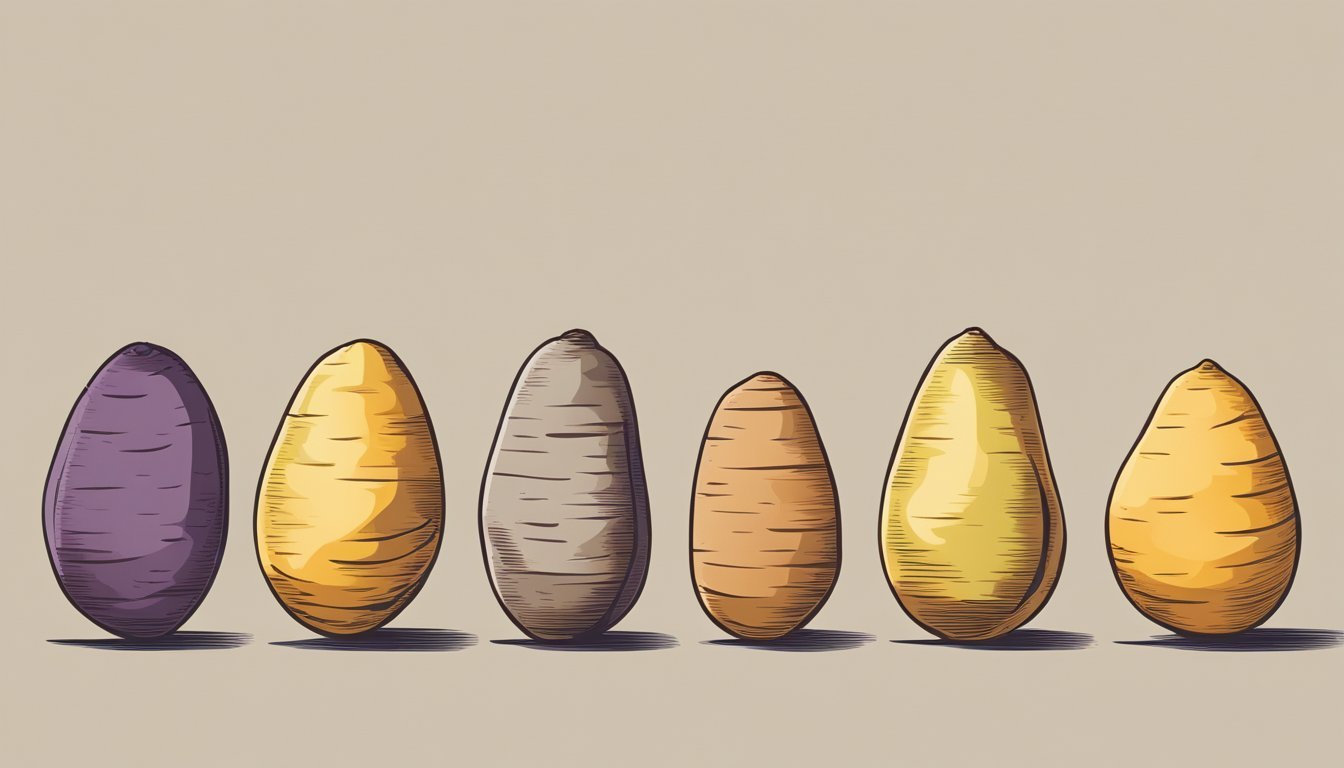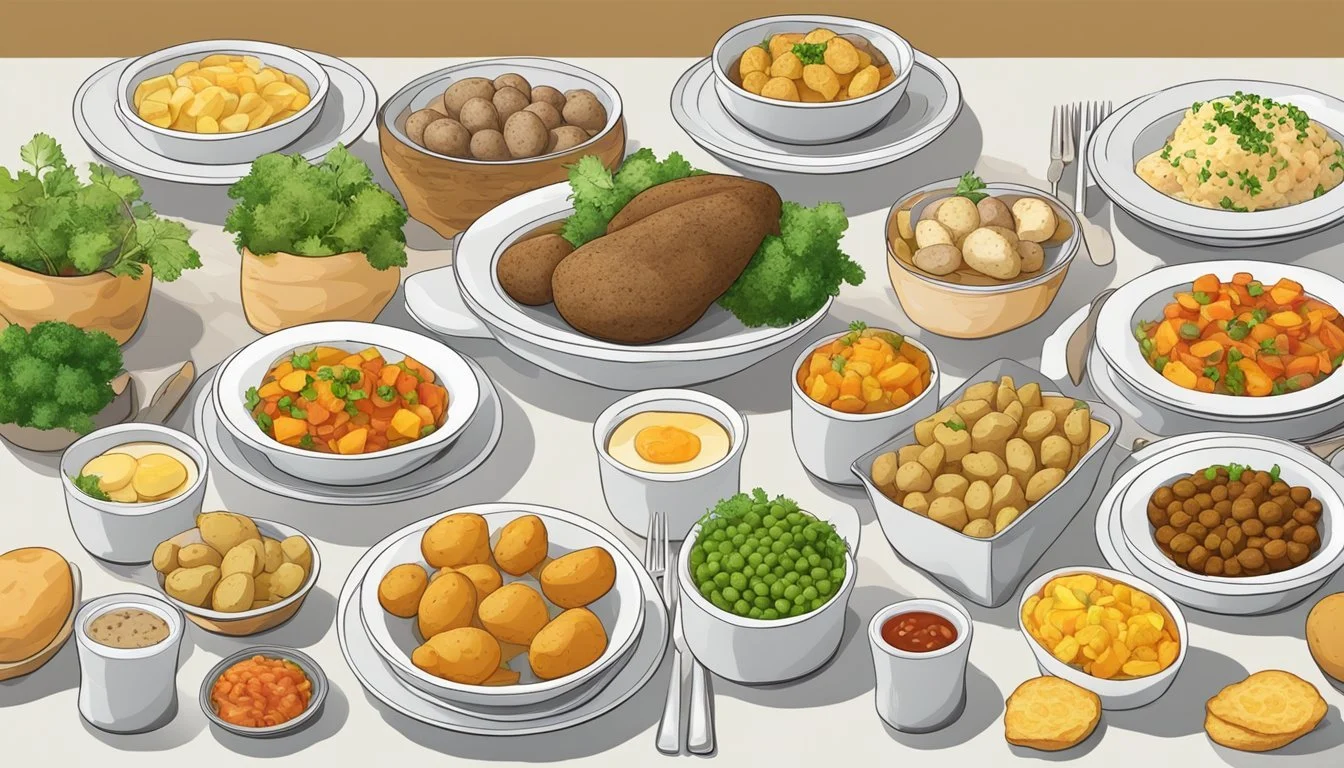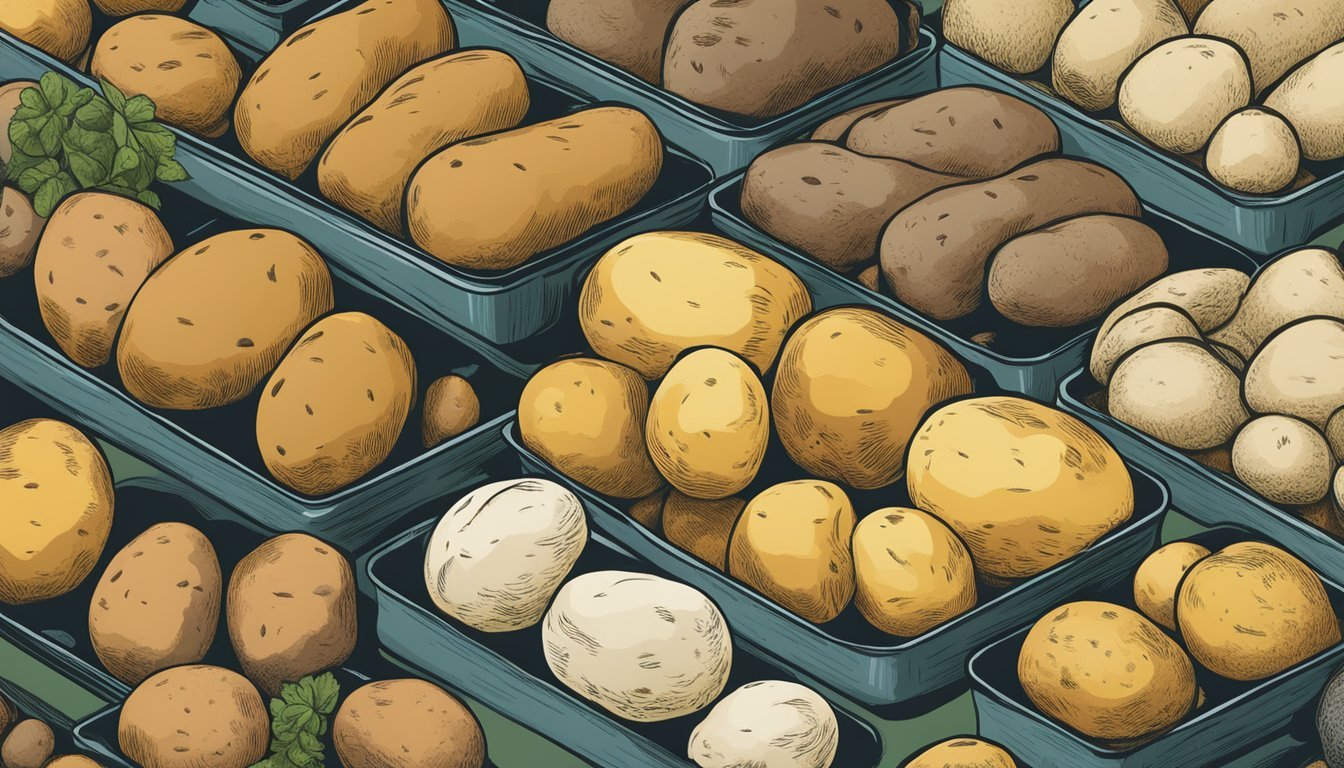How to Choose the Right Type of Potato for Every Dish
Expert Guidelines
When preparing a dish that includes potatoes, (What wine goes well with potatoes?) selecting the right variety can make a significant difference in the meal's texture and flavor. Potatoes, categorized mainly as starchy, waxy, or all-purpose, each bring a unique set of characteristics ideal for different cooking methods. Starchy potatoes, such as Russets or Idahos, are prized for their fluffy texture after cooking, which makes them perfect for baking and mashing.
On the other hand, waxy potatoes like Red-skinned or Fingerling varieties, contain less starch and more moisture, allowing them to hold their shape well during cooking. This quality makes them a superb choice for dishes where potato structure is paramount, such as potato salads, gratin, or dishes that require pan-frying. All-purpose potatoes offer a balance of starch and moisture, providing versatility that can be harnessed in an array of recipes, from roasted to boiled potatoes.
Understanding the properties of each potato type and their suitability for different culinary applications is crucial for achieving the desired outcome in potato-based dishes. It ensures not only the texture and structural integrity of the potatoes but also the overall harmony of flavors and satisfaction in every bite.
Understanding Potato Varieties
Choosing the right type of potato is crucial for culinary success, as different varieties have properties that make them suitable for specific dishes.
Starchy Potatoes
Starchy potatoes, like the Idaho or Russet, are high in starch and low in moisture, which causes them to be fluffy and dry when cooked. They're ideal for baking, mashing, or frying due to their light and crumbly texture. Their ability to absorb flavors and sauces makes them perfect for gratins or potato-based soups.
Waxy Potatoes
On the other hand, waxy potatoes contain less starch and more moisture, which allows them to hold their shape after cooking. Varieties such as Red, New, and Fingerling potatoes are typically waxy. Their firmness is excellent for boiling, roasting, or salads, where retaining structure is key.
All-Purpose Potatoes
All-purpose potatoes offer a balance between starchy and waxy varieties. Yukon Gold and white potatoes exemplify this category, showcasing a medium starch content that is versatile for most cooking methods. These potatoes are a reliable choice when you need a potato that is neither too fluffy nor too firm.
Selecting Potatoes Based on Dish Type
Choosing the correct type of potato for a dish is crucial as it can significantly impact the texture and flavor. Specific potatoes are better suited for certain preparations due to their starch content and consistency.
Fluffy Mashed Potatoes
For mashed potatoes that are light and fluffy, one should opt for starchy potatoes such as Russet or Idaho. These potatoes have a high starch content that, when cooked, become airy and absorbent, perfect for adding butter and cream.
Crispy French Fries
For French fries with a crispy exterior and tender interior, again, Russet potatoes are the ideal choice. The high starch content ensures a crispy texture when fried. It's best to soak cut potatoes in cold water to remove excess starch and then dry them thoroughly before frying to achieve the perfect crispiness.
Creamy Potato Salad
Waxy potatoes, such as Red-skinned potatoes or fingerling potatoes, maintain their shape and provide a pleasing texture in potato salad. They have a low starch content and a creamy texture, which is ideal for dishes that require the potato to stay intact among other ingredients.
Hearty Soups and Stews
When adding potatoes to soups and stews, all-purpose potatoes, like Yukon Gold, are an excellent choice. They hold up well during the cooking process and contribute a slightly buttery flavor, which makes the broth richer.
Perfect Baked Potatoes
To achieve baked potatoes with a crispy skin and fluffy interior, one should use Russet potatoes. Their thick skin crisps up well while the interior becomes soft and fluffy, suitable for filling with various toppings.
Cooking Methods and Potato Selection
Selecting the right potato for a dish is crucial, as different varieties have properties that align with specific cooking methods. This section will discuss how to match potato types to boiling, baking, roasting, frying, and steaming for optimal results.
Boiling
Boiling potatoes is a versatile method, ideal for recipes requiring a tender texture. Waxy potatoes, such as red or fingerling, maintain their shape and are excellent for boiling. They have less starch, preventing them from breaking apart in water. One should start with cold water to ensure even cooking and add a pinch of salt to enhance flavor.
Baking
For baking, russet potatoes are preferred due to their thick skin and starchy interior, which become fluffy when cooked. It is essential to bake them at a high temperature to achieve a crispy skin and to oil the skin lightly before baking to enhance the crispiness.
Roasting
When roasting, one looks for potatoes that can develop a crisp exterior while maintaining a soft interior. Small, waxy varieties can be used, but adding a bit of oil ensures a crispier result. Potatoes should be cut uniformly to ensure even cooking.
Frying
The frying method calls for potatoes like russets that can yield a crispy exterior and fluffy interior. Before frying, potatoes should be dried thoroughly to prevent oil splatter and to achieve a golden-brown finish. For crispier fries, a double frying technique is recommended: once at a lower temperature and then a second time at a higher temperature after cooling.
Steaming
Steaming is a gentle cooking method that is best for waxy and all-purpose potatoes due to their ability to hold shape and not soak up excess water. They should be cut into equal-sized pieces and steamed until tender, which preserves nutrients and flavor without the need for excess fats or oils.
The Impact of Texture and Consistency
The right potato can elevate a dish from good to great, largely due to its texture and consistency. These characteristics are influenced by the potato's moisture and starch content, which affect how it reacts to heat and how it integrates with other ingredients in a recipe.
Moisture and Starch Content
The moisture and starch content of potatoes is pivotal in determining their texture. Potatoes with high starch content, like Russets, tend to be drier and fluffier when cooked, making them ideal for light, airy mashed potatoes or crispy roasted varieties. These potatoes absorb moisture and flavors from other components in a dish, which is why they're also preferred for thickening stews. On the contrary, low starch potatoes, such as red-skinned or fingerling varieties, have higher moisture content. This keeps them firm and moist, suitable for boiling and slicing in salads where texture is key.
High-Starch Potatoes: Ideal for baking, mashing, and frying.
Examples: Russet, Idaho
Low-Starch Potatoes: Best for boiling and retaining shape.
Examples: Red-skinned, fingerling
Firmness and Shape Retention
Potatoes are sought after for their ability to either retain shape or break down under heat. The firmness and propensity of a potato to hold its shape during cooking can significantly impact the outcome of a dish. Waxy potatoes have a firm texture and are less likely to fall apart; they’re excellent choices for dishes that require intact slices or cubes, such as gratins or potato salad. Their low starch and higher moisture content contribute to their structural integrity after cooking.
Firm, Waxy Potatoes: Retain shape when cooked.
Cooking Methods: Steaming, boiling.
Best for: Potato salads, casseroles (What wine goes well with casseroles?), gratins.
Using the appropriate type of potato based on the desired texture and consistency is crucial for the success of any potato-based dish.
Flavor Profile Matching
When selecting the right potato for a dish, understanding how its flavor profile aligns with various herbs, spices, and accompanying flavors is essential. Every potato variety has its own taste characteristics that, when matched correctly with seasonings, can enhance the overall flavor of a meal.
Herbs and Spices Compatibility
Potatoes are versatile and can be paired with a wide range of herbs and spices. For starchy potatoes like Russets, which have a neutral taste, bold flavors like rosemary, thyme, and paprika work well to complement their mildness. Waxy potatoes, such as Red or fingerling potatoes, have a creamy texture that pairs well with more delicate herbs like dill and parsley to maintain their natural flavor without overwhelming it.
Starchy Potatoes (e.g., Russets):
Rosemary
Thyme
Paprika
Waxy Potatoes (e.g., Red Potatoes):
Dill
Parsley
Complementary Flavors for Potato Dishes
To enhance the natural flavors of potatoes, they often pair well with ingredients like onions and feta, which can be added to the dish to bring a balance of sweetness and saltiness. Utilizing stocks, such as chicken or vegetable stock, also complements potatoes by infusing them with depth and richness.
Ingredients for Enhanced Flavor:
Onions: Add sweetness and aromatic depth.
Feta: Offers a briny, salty kick.
Stocks (chicken, vegetable): Provide a savory base and additional moisture.
It is important to match the flavor intensity of the potato with the appropriate ingredients. A starchy potato, being more flavor-absorbent, can handle robust seasoning, while waxy varieties should be treated with a lighter touch.
Potato Preparation Tips
Selecting the right potato for your dish involves more than just the type; how one prepares the potato can greatly influence the final texture and flavor. By following proper peeling, cutting, and seasoning techniques, one ensures the potato's inherent qualities are showcased in the dish.
Peeling and Cutting
When peeling potatoes, one should consider the potato's skin and the desired final presentation. If the skin is thin and the recipe benefits from added texture, they might opt to leave it on. For a smoother texture, like in mashed potatoes, peeling is recommended. Cutting the potato should be consistent to promote even cooking:
Dicing: Ideal for soups or stews where uniform shape is important.
Slicing: Best for gratins or layered dishes where flat, even pieces ensure consistent baking.
Pre-Boiling
Boiling potatoes before the final cooking stage, whether it be roasting or frying, can drastically improve the texture. For fluffier textures, as desired in roasted potatoes, one can boil the pieces until they are just starting to soften. Here's a quick reference for pre-boiling:
Potato Type Boil Time Starchy 10-15 minutes Waxy 15-20 minutes All-purpose 12-17 minutes
Seasoning Techniques
The right balance of seasoning brings out the natural flavor of the potatoes without overpowering them. One should consider the following:
Salt: A crucial seasoning that can be added to the boiling water to infuse flavor from within.
Herbs and Spices: They should complement the potato's flavor profile; rosemary and thyme pair well with roasted potatoes, while parsley and chives might suit boiled potatoes.
Subtly is key with spices as they can easily dominate the potato's natural taste.
Advanced Potato Cooking Techniques
Mastering advanced potato cooking techniques allows a chef to elevate the humble tuber into a gourmet experience. Key considerations such as layering flavors, managing moisture, and achieving the ideal crisp can transform dishes like gratins, casseroles, and roasted potatoes.
Layering Flavors
In complex dishes like gratin and casseroles, it's critical to build a depth of flavor. Chefs should consider the type of potato and how its natural flavor will interact with other ingredients. For example:
In a gratin, one might infuse the cream with garlic and herbs before layering, allowing the subtle flavors to permeate the potatoes.
A casserole may include layers of different cheeses, each chosen for how it complements the potato and the overall flavor profile.
Managing Moisture Levels
Controlling moisture is essential to prevent dishes from becoming soggy or too dry:
Dish Technique Outcome Scalloped Potatoes Slicing potatoes thinly and evenly Ensures they cook through without excess moisture Roasted Potato Pre-soaking cut potatoes to remove starch Leads to a crisp exterior while maintaining a fluffy interior on roasting
For grilling, one should pre-cook potatoes to a certain extent to avoid a charred exterior with an undercooked interior.
Achieving the Ideal Crisp
The crispness of a potato dish can make or break its texture and appeal.
For a roasted potato, chefs often roughen the surface after boiling by shaking them in a pot, this creates more surface area for crisping.
When grilling, potatoes should be cut in uniform size to ensure even crispiness, and a light brushing of oil can protect them from drying out.
By adhering to these techniques, the resulting dishes are bound to showcase the potato's full potential.
Pairing Potatoes with Main Courses
Selecting the right type of potato for a main course involves considering the dish's flavor profile and cooking method. Proper pairing enhances both the main dish and the potato side.
Meat Dishes
For meat dishes, one must consider the cooking techniques involved.
Baked Potatoes: They complement grilled steak due to their fluffy interior and crispy skin which balance the richness of the meat.
Roasted Potatoes: Optimal with roast chicken, the potatoes absorb the flavors from the roasting pan, enhancing both the chicken and the spuds.
Mashed Potatoes: They are best served with dishes that have gravy, such as meatloaf, to take advantage of their creamy texture which pairs well with saucy meats.
Vegetarian Options
Vegetarian dishes (What wine goes well with vegetarian dishes?) can be elevated with carefully chosen potatoes.
Roasted Potatoes: The earthy element of roasted potatoes supports the natural flavors of grilled vegetables.
Mashed Sweet Potatoes: These work well with dishes like lentil burgers, adding a sweet and smooth contrast.
Fries: Ideal with veggie burgers, offering a crunchy exterior and soft interior for a satisfying textural balance.
International Cuisines
Potato recipes vary widely across international cuisines and can be matched with diverse dishes.
Baked Sweet Potatoes: In Latin American cuisines, they can be paired with black bean stews to complement the spicy and savory notes.
Roasted Potatoes: For Indian curries, roasted potatoes hold their own against the intense spices.
Mashed Potatoes: In European dishes, they often accompany breaded cutlets or schnitzel, providing a comforting counterpoint to these hearty meals.
Storing and Handling Potatoes
Proper storage and handling are crucial for maintaining the quality and extending the shelf life of potatoes. This section will cover the best practices for pantry storage, refrigerating and freezing when necessary, and measures to avoid spoilage.
Pantry Storage
Storing potatoes in a pantry should be done in a dark, cool environment, ideally between 45°F and 55°F. A heavy paper bag or a basket can be ideal containers as they allow for good airflow while protecting the potatoes from light exposure. One should avoid placing potatoes near appliances or areas where they might be exposed to heat.
Refrigerating and Freezing
Generally, refrigerating potatoes is not recommended as it can lead to the conversion of starch to sugar, causing a sweet taste and discoloration when cooked. However, leftover mashed potatoes can be kept in the fridge for a few days in a tightly sealed container. When it comes to freezing, cooked potatoes freeze well. One should store them in an airtight container or freezer bag.
Avoiding Spoilage
To prevent potatoes from spoiling:
Do not store them with onions; gases from onions accelerate potato spoilage.
Inspect regularly for signs of decay like soft spots or sprouting, and remove any affected potatoes.
Ensure they have ample ventilation to prevent moisture accumulation and mold growth.
Potato Selection for Special Occasions
Selecting the right type of potato can transform any special occasion dish into an unforgettable meal. Certain varieties lend themselves to elegant presentations and robust flavors, making them ideal choices for these events.
Impressing Guests
For dishes that are sure to impress, such as potatoes au gratin, the choice of potato is crucial. One should opt for King Edward or Maris Piper potatoes. They have a fluffy texture when cooked, holding together well under a creamy sauce while delivering a pleasing appearance on the plate.
Dish Type Potato Recommendation Why Potatoes au gratin King Edward Holds shape, creamy texture Roasted Potatoes Maris Piper Crispy outside, fluffy inside
Holiday Meals
Holiday meals (What wine goes well with holiday meals?) often demand traditional flavors and textures. Potatoes such as Maris Piper are versatile and can be roasted to golden perfection, giving a crispy exterior with a soft and fluffy interior - ideal for a festive feast.
Mashed Potatoes: Maris Piper for a smooth creamy mash.
Roast Potatoes: King Edward for a golden crunch.
Potluck Gatherings
For potluck gatherings, one seeks potato dishes that are both easy to transport and can withstand sitting at room temperature without losing quality. Waxy potatoes, like Goldilocks, are excellent for their ability to maintain structure in salads and other cold dishes.
Potato Salad: Goldilocks for its texture that holds up in creamy or vinaigrette-based salads.
Casseroles: Waxy varieties for dishes that need to stay cohesive after baking and cooling.
Addressing Common Potato Myths
When selecting the perfect potato for a dish, it's crucial to navigate through a maze of myths and misconceptions. Let us clarify some common potato myths with factual information.
Myth 1: All potatoes are created equal in cooking.
Truth: Potatoes are categorized by their starch content. Waxy potatoes like red potatoes maintain their shape and are excellent for boiling or in salads. Starchy potatoes, such as the Russet or Idaho, fluff up well making them ideal for baking and mashing. All-purpose potatoes like Yukon Golds strike a balance between the two, offering versatility.
Myth 2: New potatoes are just young potatoes.
Truth: Although 'new' refers to any young potato harvested early, these small potatoes pack a unique, slightly sweet flavor and moist texture—qualities not associated with their mature counterparts.
Myth 3: Storing potatoes in the fridge is best.
Truth: While potatoes like cool places, temperatures below 7°C (45°F) can turn starch into sugar and cause a sweet flavor upon cooking; they should be kept in a dark, cool, and well-ventilated area instead.
Here's a quick reference guide for potato selection:
Potato Type Best Use Russet/Idaho Baking, Mashing Red Potatoes Boiling, Salads Yukon Golds Roasting, Frying Waxy Potatoes Soups, Stews New Potatoes Steaming, Sautéing
Remember, the right potato can elevate a dish from good to great. Discarding these myths ensures the choice is based on fact, not fiction.
Conclusion
Choosing the right type of potato is pivotal for the success of any potato recipe. Potatoes with high starch content, such as Russets, are ideal for baking and frying due to their ability to become fluffy and absorb moisture. These are typically referred to as "floury" potatoes.
On the other hand, "waxy" potatoes like Red-skinned or Fingerlings retain their shape and have less starch, making them suitable for dishes such as potato salad or gratins. They possess a firmer texture after cooking and are less likely to disintegrate.
For those who seek a versatile option, "all-purpose" potatoes strike a balance between starchy and waxy. These spuds can adapt to a broader range of recipes, although they may not be as specialized in texture and flavor as their more specific counterparts.
In storage, it is crucial to keep potatoes in a cool, dark, and well-ventilated space to prevent sprouting and nutrient loss. Avoid storing potatoes with onions to maintain their quality.
Remember, the right potato choice will enhance the texture, flavor, and overall result of the dish. Thus, it is essential that cooks and chefs consider the specific requirements of their potato recipes before selecting their spuds.
Potato Type Best Used For Starchy (e.g., Russet) Baking, mashing, frying Waxy (e.g., Red-skinned) Potato salads, gratins All-purpose Various cooking methods
A cook's knowledge of potato varieties and their properties is sure to yield the most delicious and satisfying results.










